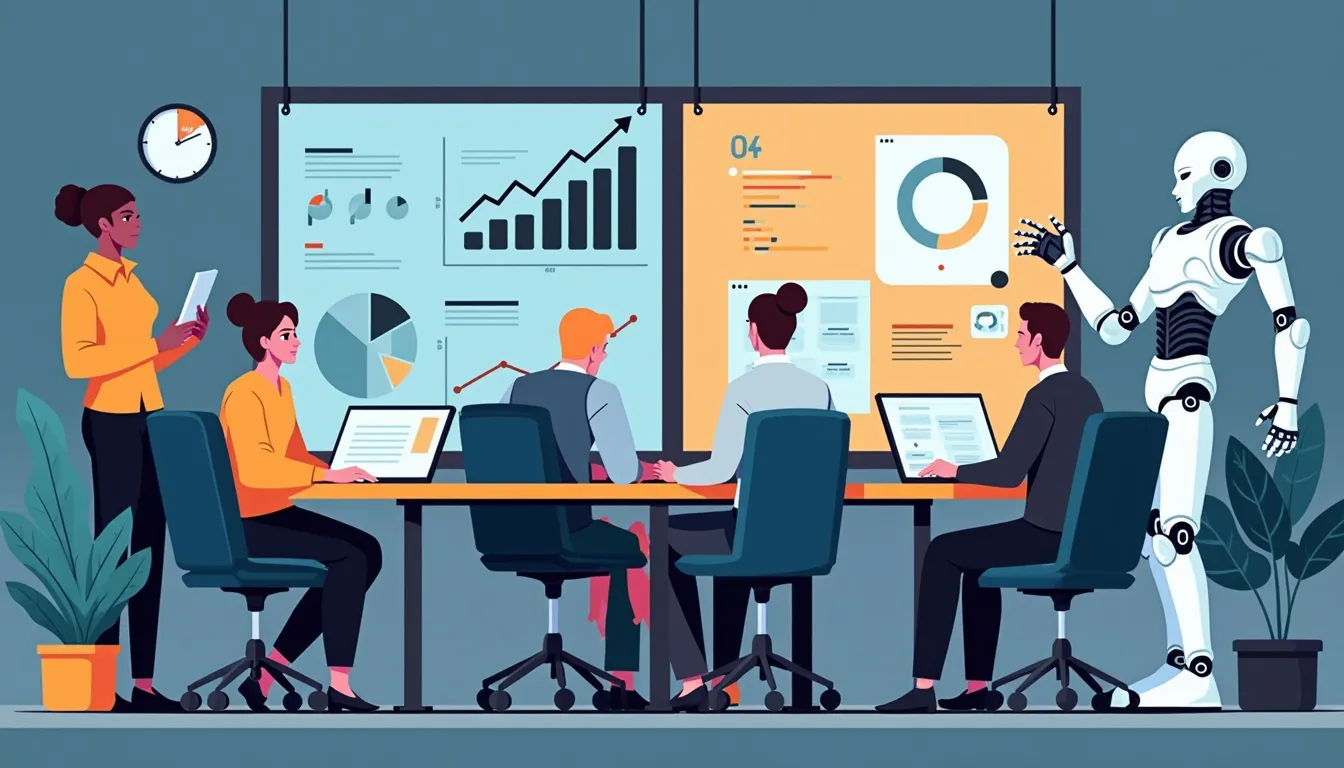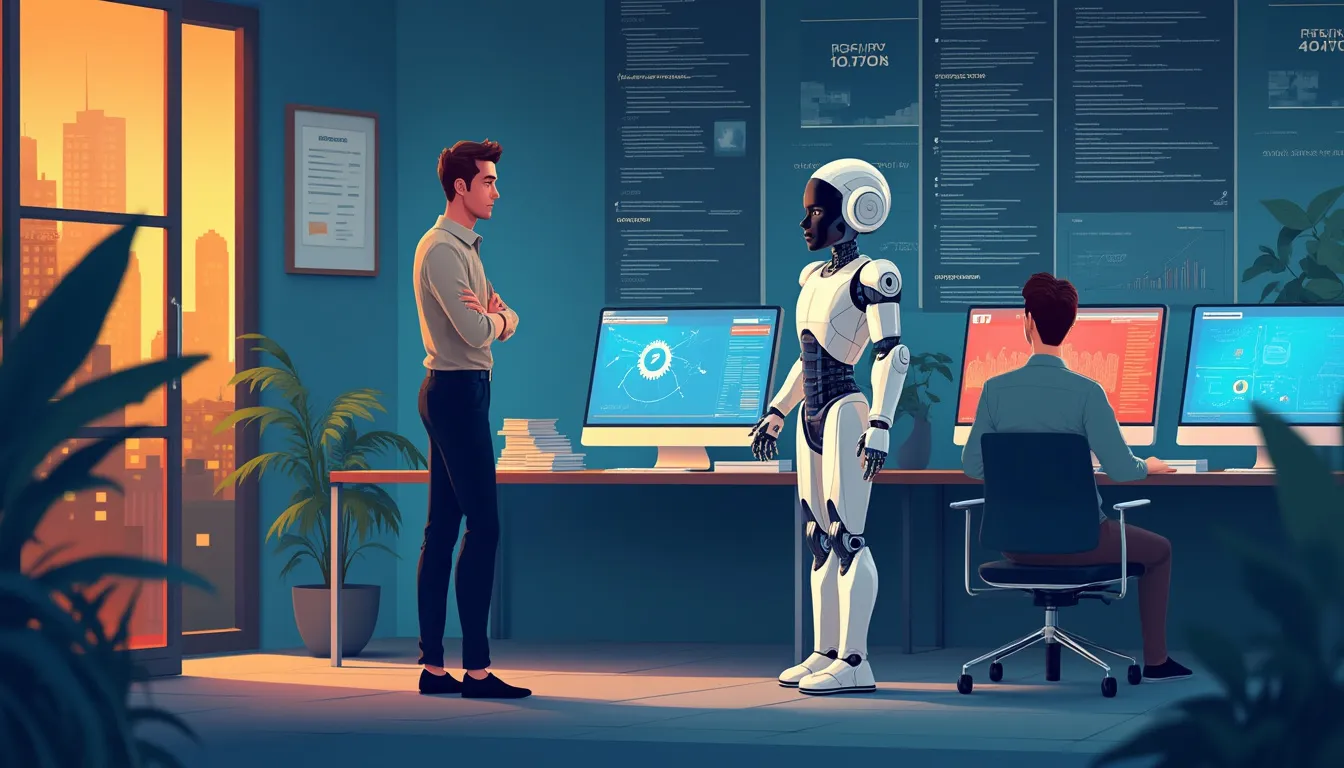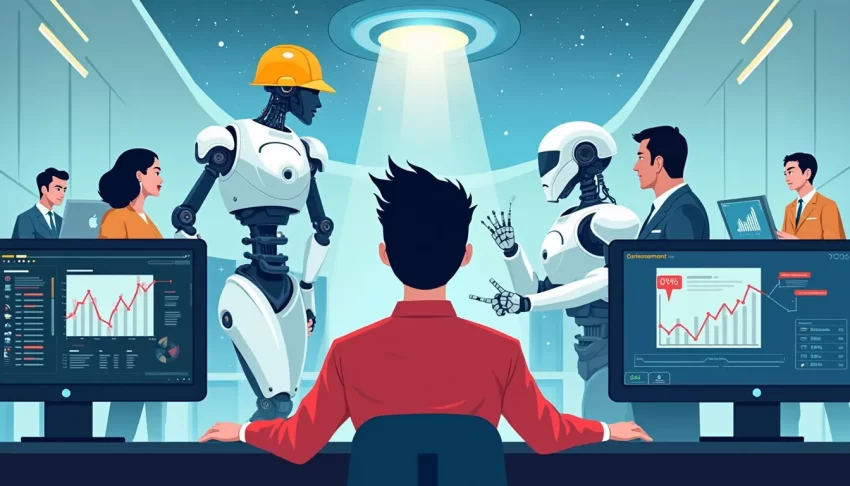In today’s rapidly evolving job market, understanding the impact of AI on job security is more crucial than ever. Artificial Intelligence, often referred to as AI, is reshaping industries with its transformative capabilities. From healthcare to finance to retail, AI is not just a buzzword; it’s a powerful tool integrating across various sectors, enhancing efficiency and opening new frontiers. However, with these advancements comes a growing concern about job security. While AI brings unparalleled opportunities, it also poses significant challenges, making it essential to address this issue head-on.
As someone with a substantial background in safety and AI, I have witnessed firsthand the waves of change brought on by technological advancements. This transformation speaks to a narrative that isn’t just professional but deeply personal. Dealing with ADHD and OCD has equipped me with a unique perspective on navigating the complexities of change, making me acutely aware of both the potential and pitfalls of AI in the job market.
AI’s impact on job security isn’t all doom and gloom. For instance, numerous AI innovations are creating new job roles that didn’t exist a few years ago. Think about AI ethics officers, machine learning specialists, and data privacy consultants—roles budding from the tech’s growth. These jobs not only offer career opportunities but also push the envelope on what can be achieved in various fields.
Nonetheless, it’s naïve to ignore the potential threats posed by AI. Automation is streamlining tasks traditionally done by humans, leading to fears of job displacement. The skills gap further exacerbates this issue, underlining the urgent need for retraining and upskilling. It’s worth examining industries like manufacturing and customer service, where automation has sparked considerable apprehension.
Navigating these waters requires a proactive approach. Continuous learning and professional development aren’t just buzzwords; they’re necessities in this brave new world. Policies and initiatives aimed at mitigating job displacement can play a pivotal role here. Both businesses and employees must adapt to this shifting landscape, embracing AI not as a threat, but as a tool for evolution.
As we delve deeper into this article, the goal is to provide a balanced perspective on how AI is altering job security—highlighting opportunities, understanding risks, and offering practical strategies to navigate this complex terrain.
Understanding the Impact of AI on Job Security
Artificial Intelligence, commonly referred to as AI, is no longer a concept confined to science fiction or academic journals. In today’s rapidly evolving job market, AI is a formidable and transformative force, reshaping various sectors, from healthcare to finance to manufacturing. But what exactly is AI, and why is its impact on job security an urgent topic of discussion?
At its core, AI refers to computer systems or machines capable of performing tasks that typically require human intelligence. This includes everything from simple decision-making and language translation to more complex functions like visual perception, speech recognition, and autonomous driving. With advancements in machine learning and neural networks, AI is now being seamlessly integrated into daily operations across numerous industries, thereby heralding a new era of efficiency and innovation.
For instance, consider how AI is revolutionizing the healthcare industry. AI-powered diagnostic tools can analyze medical images with astonishing accuracy, often exceeding human performance. Similarly, chatbots and virtual health assistants are providing instant support to patients, alleviating the burden on healthcare professionals. In such scenarios, AI is not only enhancing operational efficiency but also improving patient outcomes. However, as we celebrate these strides, we must concurrently address a pivotal concern: job security.
In traditional settings, the prospect of AI often incites a mixture of excitement and apprehension. While the technology brings about unparalleled efficiency, it also poses potential threats to conventional job structures. Take, for example, the manufacturing sector where automation and AI-driven processes are usurping manual tasks. Robots equipped with AI capabilities can perform repetitive tasks with unparalleled precision, reducing the need for human labor. Yet, amid the increasing dominance of AI, the conversation about job displacement versus job creation becomes exceedingly pertinent.
Moreover, understanding the impact of AI on job security is essential as it navigates socio-economic landscapes worldwide. Notably, AI’s rapid integration raises significant questions about the longevity of existing roles and the emergence of new job categories. The World Economic Forum estimates that while artificial intelligence could displace 85 million jobs globally by 2025, it could also create 97 million new roles better suited to the new division of labor between humans, machines, and algorithms. Evidently, this dynamic equilibrium between job displacement and job creation underscores the necessity of emphasizing adaptability and resilience in the workforce.
Given these points, the importance of discussing job security amid the rise of AI cannot be overstated. This dialogue is not an abstract exercise but a practical necessity. From policymakers to educators to industry leaders, understanding and addressing AI’s ramifications on employment is critical for devising strategies that not only mitigate potential job losses but also harness the opportunities brought about by AI innovations.
Personally, navigating through the whirlwind of professional spaces intertwined with AI, especially while managing conditions like ADHD, OCD, and weight loss, has been both a rewarding and challenging journey. My experiences have taught me that adaptability, continuous learning, and a proactive mindset are indispensable in this AI-driven job landscape. With AI progressively permeating our work environments, these attributes are equally crucial for all professionals.
In subsequent sections, we will delve deeper into the diverse facets of AI’s influence on job security, exploring both the positive impacts and the challenges it presents. Through this examination, we aim to shed light on effective strategies for safeguarding job security in this transformative age. For now, embracing both the opportunities and challenges of AI will be vital for a future where technology and human potential can coexist and thrive.

The Positive Impact of AI on Job Security
The impact of AI on job security is a nuanced conversation that often gravitates toward the potential for job displacement. However, it’s imperative to acknowledge the positive opportunities AI presents in the workforce. One glowing example is the multitude of new job opportunities created by AI innovations. Professionals around the globe are witnessing how AI is not merely a tool for replacement but a catalyst for meaningful advancements in various career paths.
New Job Opportunities Created by AI Innovations
Artificial Intelligence is a transformative force driving the creation of novel job roles that never existed before. Let’s delve into some specific examples:
In the healthcare sector, AI-driven technologies have sparked the need for specialized roles such as Data Analysts and Machine Learning Engineers. These professionals analyze medical data to train AI systems, like predictive models for patient diagnostics. Furthermore, roles like AI Ethics Consultants have emerged to guide the responsible and ethical deployment of AI applications in sensitive environments.
Similarly, the rise of AI in finance has led to new occupations such as Algorithmic Traders and Credit Risk Analysts who utilize AI algorithms to optimize investment strategies and assess financial risks. These examples highlight how technological advancements broaden the employment horizon rather than narrow it.
How AI Can Enhance Job Performance and Productivity
Aside from creating new roles, AI is substantially enhancing job performance and productivity across various existing professions. Let’s consider a few situations:
In manufacturing, AI-powered robotics are revolutionizing production lines by carrying out repetitive tasks with greater precision and speed. This allows human workers to shift their focus to more strategic tasks such as quality control and process improvement. This shift not only increases job satisfaction but also aligns with a company’s productivity goals.
In customer service, AI chatbots and natural language processing tools are handling routine inquiries, enabling human agents to tackle more complex customer issues. As someone who has juggled multiple responsibilities while grappling with ADHD and OCD, I’ve found that AI can alleviate many of the repetitive tasks that often exacerbate these conditions. This allows for a more engaged and focused workforce, contributing to higher levels of job performance and overall work satisfaction.
Examples of Industries Where AI Has Created New Roles
The extent to which AI can generate new roles is vast. Industries ranging from analytics to entertainment have witnessed the birth of specialized positions. Here are a few notable examples:
In the marketing sector, the introduction of AI has created roles such as SEO Specialists and Data-Driven Marketing Analysts. These professionals use AI tools to scrutinize consumer behavior and refine marketing strategies. AI helps them identify patterns and trends which were previously undetectable, enabling businesses to make informed decisions about their target demographics and campaign effectiveness.
Another illustrative case is the automotive industry. The push toward autonomous vehicles has unlocked new occupational fields including Autonomous Vehicle Technicians and Safety Engineers. These roles are critical in ensuring that the autonomous systems are reliable and safe for public use. My own background in safety enhances my appreciation for these positions, as they reflect how human oversight and AI technology can coalesce to elevate industry standards.
Even in the realm of entertainment, AI is shaking up traditional job landscapes. Roles such as AI Content Creators are emerging, where algorithms assist in the creation of digital content, from video games to virtual influencers. This innovative intersection of AI and creative arts opens new avenues for job seekers with diverse skill sets.
Knowing the profound ways in which AI can positively impact job security situates us in a better position to leverage these advancements for personal and professional growth. From enhancing productivity to creating entirely new job roles, the influence of AI is far-reaching and filled with opportunities.
One important takeaway here is the need for adaptability. The job market is continually evolving, and staying proactive about upskilling and reskilling can lead to a rewarding career path in this AI-driven era. For anyone struggling with personal challenges like ADHD, OCD, or weight management, as I have, the key lies in recognizing that AI can be an ally in mitigating repetitive tasks and enhancing focus. The future is bright for those who are prepared to harness the potential AI brings to the workforce.

The Challenges and Threats AI Poses to Job Security
While the potential benefits of artificial intelligence (AI) are multifaceted, we must also address the significant challenges and threats it poses to job security. The impact of AI on job security includes potential job displacement, a widening skills gap, and the pressing need for retraining and upskilling. Let’s delve deeper into these aspects to better understand the landscape ahead.
Potential Job Displacement Due to Automation and AI
The most immediate and perhaps most daunting challenge AI presents is the potential displacement of jobs as a result of automation. AI’s ability to perform repetitive, mundane, and even complex tasks more efficiently than humans threatens various roles across industries. For instance, manufacturing sectors, deeply rooted in routine and precision, are increasingly automating tasks historically performed by human workers. The transition from manual labor to machine-driven processes, while enhancing productivity, can displace a sizable portion of the workforce.
Consider the automotive industry, which has a long history of integrating automation. As AI technologies continue to evolve, more intricate tasks that once required human touch are now automated. Robotic arms, equipped with AI-driven vision systems, now entirely handle the assembly lines. This shift not only reduces human error but also significantly cuts labor costs, leading to fewer jobs for assembly line workers.
Skills Gap and the Need for Retraining and Upskilling
Navigating the impact of AI on job security also brings to light the growing skills gap. As AI takes over more technical and specialized tasks, the demand for a highly skilled workforce sharply increases. However, there’s a disconnect between the skills required by emerging AI technologies and the current capabilities of the workforce.
An illustrative example can be found in the healthcare industry. Medical professionals are now expected to interact with AI-driven diagnostic tools. These tools, though making the diagnostic process faster and more accurate, require physicians and technicians to possess a new set of skills, ranging from data analysis to a fundamental understanding of machine learning algorithms.
Addressing this skills gap necessitates comprehensive retraining and upskilling programs. Companies, educational institutions, and governments must collaborate to offer platforms for continuous learning. Such initiatives not only help individuals maintain relevancy in the job market but also spur innovation and adaptability within industries.
My personal journey managing ADHD and OCD illuminates the value of adaptability. Coping with these challenges has required me to constantly evolve my strategies and skill sets. Similarly, the workforce must embrace a culture of evergreen learning to thrive amidst AI advancements.
Case Studies of Industries and Roles Most at Risk from AI
Examining industries and specific roles most susceptible to AI disruption provides actionable insights for stakeholders. The most vulnerable roles often feature repetitive tasks requiring little to no critical thinking—a forte of AI capabilities. Below are briefs on industries and their respective roles at significant risk:
-
Logistics and Warehousing
The logistics sector, fundamental to global trade, is undergoing a transformation via AI. Warehouse workers, traditionally responsible for inventory management and package sorting, face stark job insecurity due to AI-driven robots. Automated guided vehicles (AGVs) and robotic sorters are rapidly replacing humans in logistics hubs.
-
Financial Services
In the realm of financial services, roles centered on data entry and basic analysis are dwindling. AI algorithms excel in these areas, automating processes such as underwriting and fraud detection. Financial analysts are now tasked to focus on more complex, strategic functions—an adaptation demanding significant upskilling.
-
Customer Service
Customer service roles are highly susceptible, as AI-driven chatbots and virtual assistants become increasingly sophisticated. Routine inquiries and data handling are now efficiently managed by AI, posing job security challenges for many frontline service staff. This transformation necessitates shifts towards more complex customer interaction roles.
These case studies underscore a reality where job displacement is real, urging us to think critically about the impact of AI on job security. Nevertheless, it also presents an opportunity to engineer pathways for translating these challenges into growth and innovation.
Notably, my personal struggle with weight loss highlights a parallel here. Stepping into a healthier lifestyle demanded a shift from old habits toward new, challenging routines. Similarly, adapting to AI advancements requires the workforce to step out of comfort zones, embrace new skills, and navigate the changing landscape.
By acknowledging these challenges and proactively addressing them, we can carve a future where AI complements human potential rather than diminishes it.

Strategies for Safeguarding Job Security in the Age of AI
As we delve into the age of artificial intelligence, the imperative for both businesses and employees to adapt has never been more evident. The impact of AI on job security, while a source of anxiety for many, can be managed effectively through several strategic approaches. By engaging in continuous learning and professional development, implementing forward-thinking policies, and fostering adaptability, we can navigate this transformative landscape with confidence.
Importance of Continuous Learning and Professional Development
The rapid evolution of AI demands an equally swift response in skills development. Continuous learning is not just an option but a necessity in preserving job security. For instance, during my own career in safety and AI, I have witnessed firsthand how professionals who continually update their skills stay ahead of the curve. Consider the story of a mid-level manager in a manufacturing firm who initially worried about robots replacing his role. By taking courses in AI and robotics, he transformed his career trajectory, becoming an indispensable asset who manages and collaborates with the very machines he once feared would replace him.
Additionally, resources such as online courses, professional certifications, and workshops can significantly bridge the skills gap. Platforms like Coursera, Udacity, and Khan Academy offer tailored programs suited to various industries, ensuring that employees can acquire the necessary knowledge without disrupting their current employment. Furthermore, the concept of microlearning—short, focused learning modules—has gained traction. This approach caters well to individuals, like myself, juggling multiple responsibilities and conditions such as ADHD and OCD. By engaging in concise, manageable learning sessions, employees can make consistent progress without feeling overwhelmed.
Policies and Initiatives that Help Mitigate Job Displacement
While individual efforts are crucial, systemic support is equally vital in protecting job security from the impact of AI. Governments and organizations can play a pivotal role by formulating policies and initiatives designed to cushion the blow of technological advancement. For example, the introduction of workforce development programs can prepare employees for the future job market. In several countries, public-private partnerships have been established to offer subsidized training in AI and related fields.
Moreover, businesses can adopt job-sharing and role rotation practices. By allowing employees to experience different facets of the organization, they develop a broader skill set that can buffer against AI-driven redundancy. This holistic approach not only enhances employee versatility but also fosters a culture of intra-organizational mobility. As a case in point, a tech firm I collaborated with initiated a ‘rotational training program,’ which saw remarkable results. Employees who participated in the program reported increased job satisfaction and exhibited reduced anxiety about AI-related changes, as they felt more equipped to handle diverse roles.
Another sensible policy is the implementation of lifelong learning stipends whereby companies allocate funds annually for each employee to pursue educational endeavors. This investment in human capital not only prepares the workforce for AI integration but also engenders loyalty and commitment from employees. A notable example is a multinational consultancy firm that offers an annual learning stipend of $1,500 to its staff; the program has led to heightened engagement and retention rates.
How Businesses and Employees Can Adapt to the Evolving Job Landscape Powered by AI
Adaptability remains central to thriving amidst the evolving AI landscape. Businesses must foster a culture of agility, encouraging employees to innovate and adapt. For example, my experience in advocating for flexible work environments stems from the realization that adaptability is indispensable. When I was undergoing a weight loss journey, flexibility in work allowed me to manage my health better while staying productive—an ethos that aligns well with adjusting to AI-induced changes.
Creating an environment where experimentation and iterative learning are valued can mitigate the fear of AI-driven obsolescence. This means celebrating small milestones and learning from failures, which is especially pertinent in sectors experiencing rapid AI integration. To draw from real-world experience, a friend and startup owner redefined his company’s operational strategies by adopting a ‘fail-fast, learn-fast’ mentality. This openness to iterative improvement spurred a culture of innovation and adaptability, equipping employees to better handle AI advancements.
On an employee level, proactively seeking to understand AI-related trends within one’s industry can make a significant difference. Engaging in professional communities, attending industry conferences, and participating in webinars can provide critical insights. For those like myself who struggle with attention issues, breaking down information consumption into smaller, more digestible chunks can be particularly effective. Using tools like RSS feeds or curated newsletters ensures that staying informed doesn’t become an overwhelming task.
By focusing on these strategic approaches, both businesses and employees can turn the potential threat of AI into an opportunity. The emphasis on continuous learning, supportive policies, and adaptable mindsets enables a future where AI complements rather than compromises job security. After all, as much as AI evolves, the human capacity for growth and adaptation remains unparalleled.
As we navigate the ever-evolving landscape of artificial intelligence, it’s clear that AI’s impact on job security is both profound and multifaceted. While AI heralds a future filled with innovative opportunities and enhanced productivity, it also poses significant challenges that demand our urgent attention and response.
AI is not just an abstract concept but a dynamic force driving change across all sectors. From healthcare to finance, AI technologies are revolutionizing the way we work, often acting as both a catalyst and a disruptor. On one hand, the emergence of AI has led to the creation of entirely new job categories—roles unimaginable a few decades ago. These include data scientists, AI ethicists, and automation specialists, to name a few. By augmenting human capabilities, AI enhances job performance and productivity, ultimately allowing businesses to thrive.
However, this transformation comes with its set of challenges. The specter of job displacement looms large, especially for roles that are repetitive and easily automated. This shift underscores the pressing need for a workforce equipped with new skills tailored to an AI-driven future. Industries ranging from manufacturing to customer service are already witnessing significant changes, necessitating retraining and upskilling initiatives to bridge the skills gap.
So, how do we safeguard job security in this era of AI? Continuous learning and professional development remain pivotal. Whether you are starting your career or are a seasoned professional, adapting to the technological advancements is non-negotiable. Governments, educational institutions, and businesses must collaborate to develop policies that support ongoing education and skill acquisition. Upskilling workshops, AI-related courses, and adaptive learning platforms are invaluable tools in this endeavor.
Moreover, organizations must embrace AI as an ally rather than an adversary. By fostering an environment of lifelong learning and resilience, businesses can help employees navigate the transition seamlessly. Proactive measures such as offering retraining programs and investing in employee development can mitigate the risk of job displacement.
In conclusion, the influence of AI on job security is a double-edged sword—teeming with possibilities and challenges. By recognizing the necessity of continuous learning and embracing adaptive strategies, we can turn potential threats into opportunities for growth. As individuals and organizations, the call to action is clear: stay informed, stay adaptable, and stay committed to shaping a future where AI serves as a cornerstone of job security, not a detriment.
After all, in a world where change is the only constant, our ability to adapt remains our greatest asset. So, let’s champion innovation while fortifying our skills and resilience, ensuring a prosperous and secure future in the age of AI.
Support Us: Check out our recommended products on Amazon.

